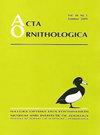白喉杓鹬羽化后的生存与扩散
IF 1.3
4区 生物学
Q3 ORNITHOLOGY
引用次数: 0
摘要
摘要即使在其他经常研究的物种中,羽化后时期仍然是鸟类生命周期中研究不足的阶段。白喉北斗七星的一般繁殖生物学是众所周知的,但只有少数研究集中在羽化后时期的生存和扩散。在这项研究中,我们报告了无线电遥测的结果,这种方法迄今为止还没有在该物种中使用过。斯洛伐克中部山区种群中的雏鸟(来自9个巢的37只)被无线电标记为平均预期幼鸟年龄(孵化后22天),并每天进行监测,直到死亡、失踪或独立。只有22-32%的幼鸟(取决于对不确定数据的处理)在幼鸟出生后的前12天存活下来。捕食是最常被怀疑的死亡原因。羽化后的前两天(0.717-0.758)的日存活率明显低于羽化后(0.914-0.941)。羽化后第一周的日移动距离保持稳定,并在达到独立年龄前后(约羽化后12天)增加。另一方面,离出生巢的距离和窝内距离(同一巢的幼鸟所占的河流长度)自幼鸟开始逐渐增加。我们提出,在我们的研究种群中,幼鸟出笼后的低存活率可能会通过频繁的更新和/或双重育婴来平衡,这一时间与幼鸟在出生地以外分散时达到独立的年龄非常吻合。本文章由计算机程序翻译,如有差异,请以英文原文为准。
Post-Fledging Survival and Dispersal of the White-Throated Dipper Cinclus cinclus
Abstract. The post-fledging period is still an understudied stage of avian life cycle, even in the case of otherwise frequently studied species. The general breeding biology of the White-throated Dipper is known well, but only a few studies have focused on survival and dispersal during the post-fledging period. In this study we report on results revealed by radio-telemetry, a method which has not been used in the species to date. Nestlings (37 individuals from 9 nests) in a mountain population of central Slovakia were radio-tagged on the mean expected fledging age (22 days post-hatch) and monitored daily until death, disappearance or reaching independence. Only 22–32% (depending on the handling of uncertain data) of fledglings survived the first 12 days post-fledging. Predation was the most frequently suspected cause of death. The daily survival rate was markedly lower during the first two days after fledging (0.717–0.758) than later (0.914–0.941). The daily movement distance remained stable during the first week post-fledging and increased around the age of reaching independence (c. 12 days post-fledging). On the other hand, the distance from the natal nest and the within-brood distance (length of river occupied by fledglings from the same nest) increased gradually since fledging. We propose that in our study population the low post-fledging survival could be potentially balanced by frequent renesting and/or double-brooding, timing of which corresponds well with the age of reaching independence when juvenile birds disperse outside the natal territory.
求助全文
通过发布文献求助,成功后即可免费获取论文全文。
去求助
来源期刊

Acta Ornithologica
生物-鸟类学
CiteScore
2.10
自引率
0.00%
发文量
14
审稿时长
>12 weeks
期刊介绍:
Publishes scientific papers (original research reports, reviews, short notes, etc.) and announcements from all fields of ornithology. All manuscripts are peer-reviewed.
Established in 1933 as Acta Ornithologica Musei Zoologici Polonici, since 1953 continued under the present title.
Published twice a year by the Natura Optima Dux Foundation under the auspices of the Museum and Institute of Zoology, Polish Academy of Sciences.
 求助内容:
求助内容: 应助结果提醒方式:
应助结果提醒方式:


